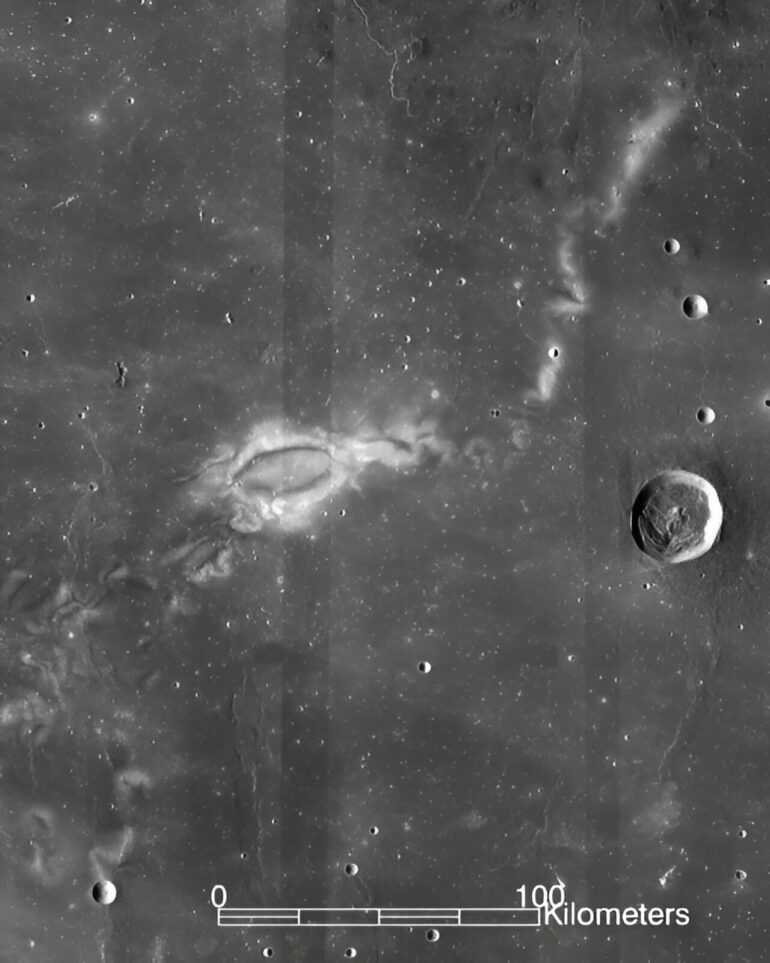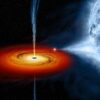Lunar swirls have been traditionally considered to be unaffected by topographic changes, but a new study shows a correlation between the two. Lunar swirls are high-albedo markings on the moon that occur in both mare—dark, level basalt plains—and the bright highland terrains; their origin remains a point of debate.
“The canonical interpretation of lunar swirls is that topography has no bearing on the location or shape of the swirl. However, Domingue et al. found the bright areas of the lunar swirl in Mare Ingenii have a lower elevation than the dark lanes between them.
They reached this conclusion by generating and examining topographic data for lunar swirls at a higher resolution than had previously been performed (i.e. sub-meter),” said John Weirich, a Senior Scientist at the Planetary Science Institute and lead author of “The Search for Topographic Correlations within the Reiner Gamma Swirl” that appears in Planetary Science Journal. PSI’s Deborah L. Domingue, Frank C. Chuang, Amanda A. Sickafoose, Matthew D. Richardson, Eric E. Palmer, and Robert W. Gaskell are co-authors.
There are regions on the moon where contrasting bright and dark markings seemingly loop across the surface; these markings, known as swirls, are defined by broad, bright, on- swirl areas separated by darker off-swirl lanes. Their formation mechanism has long been debated and is key for understanding the processing of the lunar surface, the mobility of the lunar soil particles, and the effects of the space environment on planetary surfaces, according to Domingue et al. (2022).
“This paper builds upon the conclusion of Domingue et al. by using the same methods and finds a similar correlation between on-swirl areas and lower topography within the Reiner Gamma swirl. Finding a relationship with topography in one swirl location could just be a fluke, but finding it in two vastly separate swirl regions is harder to ignore. It is especially hard to ignore because Reiner Gamma is the archetypical lunar swirl,” Weirich said.
“Domingue et al. found the bright areas are 2 to 3 meters lower than the dark areas within the Mare Ingenii lunar swirl. In this paper we studied Reiner Gamma and found the bright areas are about 4 meters lower than the dark areas,” Weirich said.
“However, it is not as simple as the bright areas are uniformly lower than the dark areas. If that was the case this relationship between topography and swirl would be easy to demonstrate by comparing an elevation map to a picture of the swirl. Instead, this relationship is only seen when we compare the average height of the bright areas and the average height of the dark areas.”
Weirich used many Lunar Reconnaissance Orbiter Camera (LROC) images along with the Stereophotoclinometry (SPC) software suite to determine the topography of the surface.
Co-authors Chuang and Richardson used machine learning tools on a subset of the LROC images to apply an unbiased algorithm to classify the swirl into bright areas, called the on-swirl units, and dark areas, called off-swirl. They also identified transitionary/intermediate areas, which they labeled as a diffuse-swirl unit. They published their findings in an earlier paper.
SPC is a software suite that utilizes spacecraft images of a surface, and combines stereo imaging and photoclinometry to determine the height of a surface. The swirl units defined by the machine learning algorithms were then compared to the SPC derived topography to statistically determine if height correlations existed, and if so, what is the difference.
“Lunar swirls have piqued scientists’ interest since they were discovered, partly because the scientific community doesn’t completely understand how they formed. There are many hypothesis about their formation process. Each hypothesis has observations that support it, but there are also other observations that contradict them,” Weirich said.
“Since we don’t have a full understanding on how these swirls formed, we don’t completely understand the story they can tell us about the moon. Forming them could involve a combination of well-understood processes interacting together, or a currently unknown process. Unusual objects or phenomenon are sometimes the key to obtaining deeper knowledge, and for this reason lunar swirls are very intriguing. And the fact that they look really cool.”
More information:
John R. Weirich et al, The Search for Topographic Correlations within the Reiner Gamma Swirl, The Planetary Science Journal (2023). DOI: 10.3847/PSJ/ace2b8
Provided by
Planetary Science Institute
Citation:
New study finds lunar swirls linked to topography (2023, November 9)



